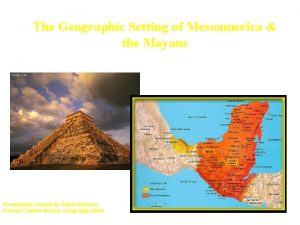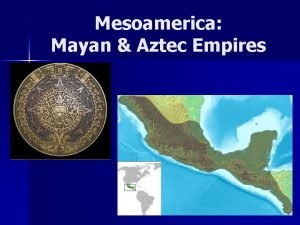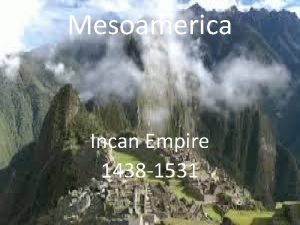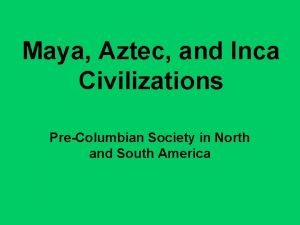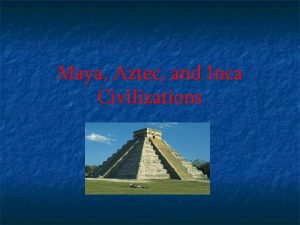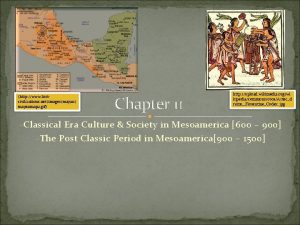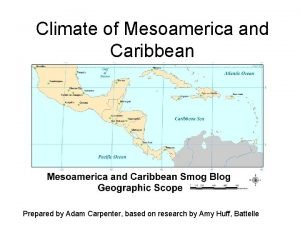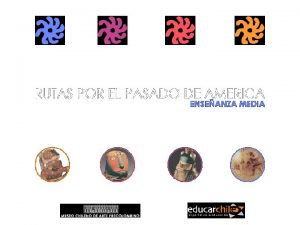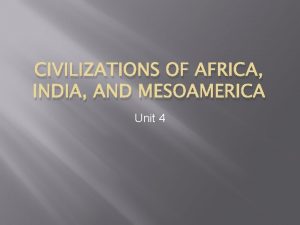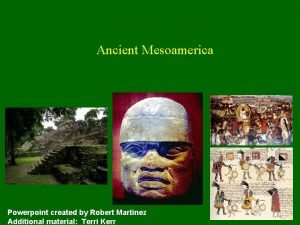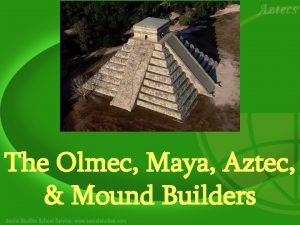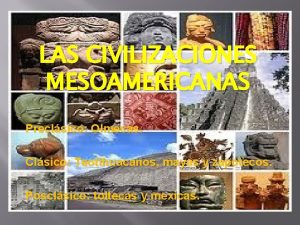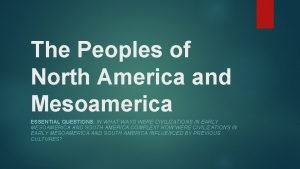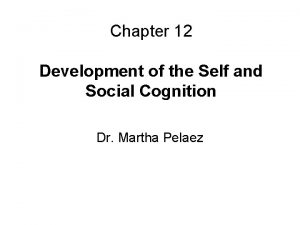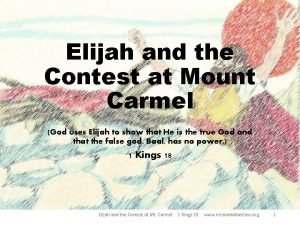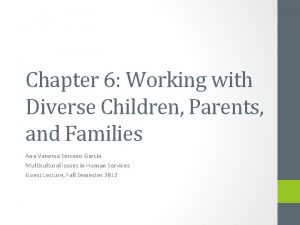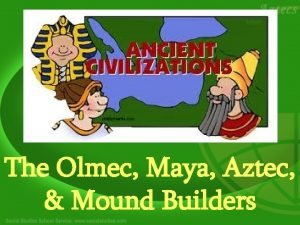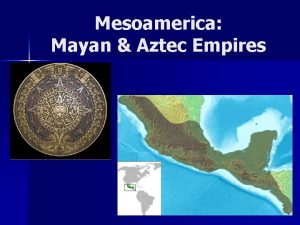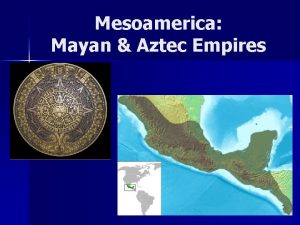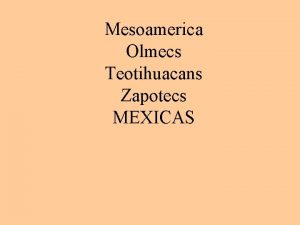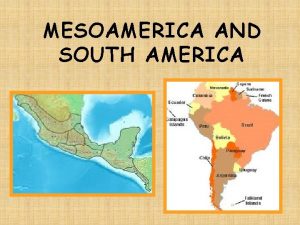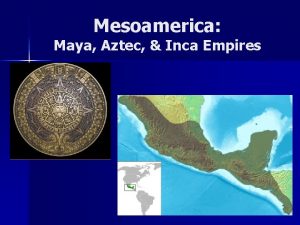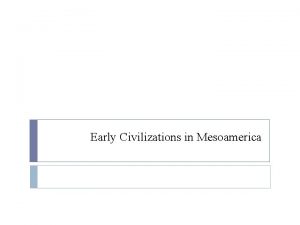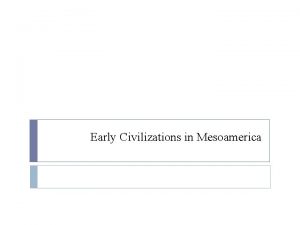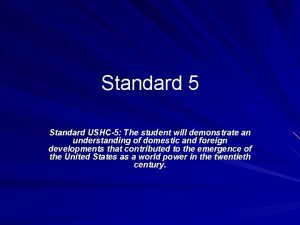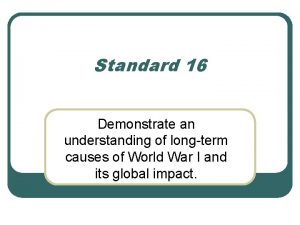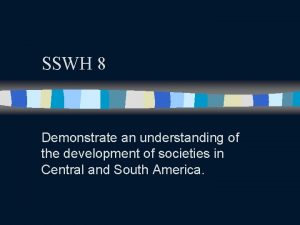Mesoamerica Standard Demonstrate an understanding of the development
























- Slides: 24

Mesoamerica • Standard: Demonstrate an understanding of the development of societies in Central and South America. • Essential Question: How did the societies in Central and South America develop?


Mesoamerica’s Rise and Fall • Element: Explain the rise and fall of the Olmec, Mayan, Aztec, and Inca empires. • Vocabulary: Olmec, Mayan, Aztec, Inca empire

Mesoamerica • the name for areas of Mexico and Central America • were civilized before the Spanish arrived

Olmec: Rise • began around 1200 B. C. • in the hot, swampy lowlands on the coast south of Veracruz, Mexico • farmed the area’s muddy riverbanks • built large cities that were centers of religious rituals

Olmec: Fall • collapsed around 400 B. C. • Reason unknown

Maya: Rise • flourished between A. D. 300 and 900 • on the Yucatán Peninsula • City-states form

Maya: Fall • Most Mayan cities were mysteriously abandoned around AD 800 s • Suggested causes for decline: – Warfare among city-states – Disruption of trade and economic hardships – Over farming and population growth that resulted in ecological damage which resulted in food shortages, famine and disease

Aztec: Rise • 1200 -1521 • Sometime during the twelfth century A. D. • began a long migration to the Valley of Mexico • established their capital at Tenochtitlán – an island in the middle of Lake Texcoco (Mexico City) • Aztec power increased by taking neighbor’s land through war


Hernan Cortes • in 1519 a Spanish force under the command of Hernán Cortés landed at Veracruz • marched to Tenochtitlán • Cortés had only 550 soldiers and 16 horses

Aztec: Fall • the monarch, Montezuma (Moctezuma) gave the Spanish gifts of gold • tensions eventually arose between the Spanish and the Aztec • by 1520, the Spanish forces had destroyed the city of Tenochtitlán

Inca: Rise • flourished in South America in the fifteenth century • developed in the Andes Mountains • in the 1440 s began to expand their lands • extended as far as Ecuador, central Chile, and the edge of the Amazon basin

Francisco Pizarro • The first Spanish expeditions arrived in the central Andes in 1530 • under the command of Francisco Pizarro • only had a small band of about 180 men • Armed with steel weapons, gunpowder, and horses

Inca: Fall • experienced a smallpox epidemic that destroyed villages and killed the emperor • Armed with stones, arrows, and light spears, the Inca could not defeat the Spanish • Pizarro captured the capital Cuzco with the help of Incan allies • by 1535 Pizarro had established a new capital at Lima for a new colony of the Spanish Empire

Mesoamerican Culture • Element: Compare the culture of the Americas to include government, economy, religion and the arts of the Mayans, Aztecs and Incas.

Government Mayans Independent city-states ruled by a king/priest. Power gained through hereditary means. Aztecs Had a central emperor with regional rulers who paid tribute to the emperor. Incas Led by a king with the empire divided into units. All towns were connected to the capital by roads. Citizens expected to work a certain number of days for the state

Incan Roads

Economy Mayans Based on agriculture and trade (salt, feathers, jade) Aztecs Based on agriculture and trade. Goods paid as tributes from conquered peoples. Incas Based on trade and self-sufficient farming

Religion Mayans Aztecs Incas Central to Mayan life. Worshiped multiple gods. Some human sacrificemainly worshiped through prayer and assorted offerings. Central to Aztec life. Worshiped multiple gods. Large scale human sacrifice to the Sun God. Ancestor worship with human sacrifice on special occasions

Arts Mayans Developed a religious calendar based on astronomy and an advanced writing system. Carved jade, built pyramids. Aztecs Incas Developed a calendar similar to the Mayans. Built pyramids. Paintings and pottery were usually religious or war based in theme. Worked metal, pottery and cloth



 Demonstrate knowledge and understanding
Demonstrate knowledge and understanding Geography of mesoamerica
Geography of mesoamerica Climate of the aztec empire
Climate of the aztec empire Terrace farming mesoamerica
Terrace farming mesoamerica Mesoamerica inca
Mesoamerica inca Inca vs maya
Inca vs maya Mesoamerica inca
Mesoamerica inca Society
Society Chinampas del viso
Chinampas del viso Climate of mesoamerica
Climate of mesoamerica Similarities between inca maya and aztec
Similarities between inca maya and aztec Mesoamerica culturas
Mesoamerica culturas Arte precolombino latinoamericano
Arte precolombino latinoamericano Maya farming
Maya farming Mesoamerica powerpoint
Mesoamerica powerpoint Causeway mesoamerica
Causeway mesoamerica Periodo clasico teotihuacanos mayas y zapotecos
Periodo clasico teotihuacanos mayas y zapotecos The peoples of north america and mesoamerica
The peoples of north america and mesoamerica Understanding standard deviation
Understanding standard deviation Development of self and social understanding
Development of self and social understanding Schemes of repetition
Schemes of repetition The contest on mount carmel was to demonstrate that
The contest on mount carmel was to demonstrate that Edip teaching
Edip teaching Bicultural couples tend to demonstrate extremes in
Bicultural couples tend to demonstrate extremes in Which feature does this image demonstrate?
Which feature does this image demonstrate?

